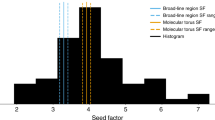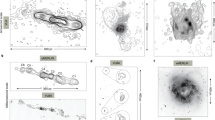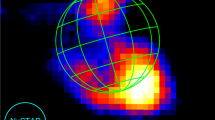Abstract
IT has been suggested1 that the explosion of a primordial black hole (pbh) might produce a coherent radio pulse detectable at a distance of ∼ 104 pc with a simple antenna. Several searches2–5 for radio pulses arriving from random directions in space, such as might be produced by supernovae5–7, have already been carried out using wide beam (all-sky) antennas, and the negative results obtained are used here to place limits on the pbh radio pulse emission rate per unit volume. An indication has already been given8 of the limits which some previous radio searches impose, and of the influence of antenna aperture and beamwidth on achievable limits. This paper presents a more general analysis of limit criteria, including consideration of the effects on the pulse timescale of the interstellar medium, and examines the factors which determine the optimum search strategy for pbh radio pulses. It is reported that the best radio limit4 known to the author, could be improved by at least times 106 using existing techniques. In addition, examination of this existing limit4 shows that it is already ∼ 80 times better (99.5% confidence level) than a limit which it has been suggested8 might be attainable in the optical region, and is ∼ 106 times better than pbh explosion rate limits obtained from γ-ray observations9,10, although the γ-ray limits do not involve the generation of a coherent electromagnetic pulse.
This is a preview of subscription content, access via your institution
Access options
Subscribe to this journal
Receive 51 print issues and online access
$199.00 per year
only $3.90 per issue
Buy this article
- Purchase on Springer Link
- Instant access to full article PDF
Prices may be subject to local taxes which are calculated during checkout
Similar content being viewed by others
References
Rees, M. J. Nature 266, 333–334 (1977).
Charman, W. N. et al. Nature 228, 346–348 (1970).
Troitskii, V. S. et al. Radiophys Quant. Electron. 16, 239–252 (1975), Trans. Radiofiz. 16, 323–341 (1973).
Huguenin, G. R. & Moore, E. L. Astrophys. J. Lett. 187, L57–L58 (1974).
Colgate, S. A., McKee, C. R. & Blevins, B. Astrophys. J. Lett. 173, L87–L91 (1972).
Jelley, J. V., Baird, G. A. & O'Mongain, E. Nature 267, 499–500 (1977).
Page, D. N. & Hawking, S. W. Astrophys. J. 206, 1–7 (1976).
Porter, N. A. & Weekes, T. C. Astrophys. J. 212, 224–226 (1977).
Sironi, G. Mon. Not. R. astron. Soc. 166, 345–353 (1974).
Webster, A. S. Mon. Not. R. astron. Soc. 166, 355–371 (1974).
Daniel, R. R. & Stephens, S. A. Space Sci. Rev. 17, 45–158 (1975).
Readhead, A. C. S. & Duffett-Smith, P. J. Astron. Astrophys. 42, 151–153 (1975), Mon. Not. R. astron. Soc. 174, 7–17 (1976).
Condon, J. J. & Backer, D. C. Astrophys. J. 197, 31–38 (1975).
Author information
Authors and Affiliations
Additional information
The erratum article can be found online at https://doi.org/10.1038/269450b0
Rights and permissions
About this article
Cite this article
MEIKLE, W. Upper limits for the radio pulse emission rate from exploding black holes. Nature 269, 41–42 (1977). https://doi.org/10.1038/269041a0
Received:
Accepted:
Issue Date:
DOI: https://doi.org/10.1038/269041a0
This article is cited by
-
Interacting quantum fields around a black hole
Communications in Mathematical Physics (1981)
-
Zum Verdampfen und anderen Eigenschaften Schwarzer L�cher
Naturwissenschaften (1979)
-
Limits on cosmic radio bursts with microsecond time scales
Nature (1978)
Comments
By submitting a comment you agree to abide by our Terms and Community Guidelines. If you find something abusive or that does not comply with our terms or guidelines please flag it as inappropriate.



